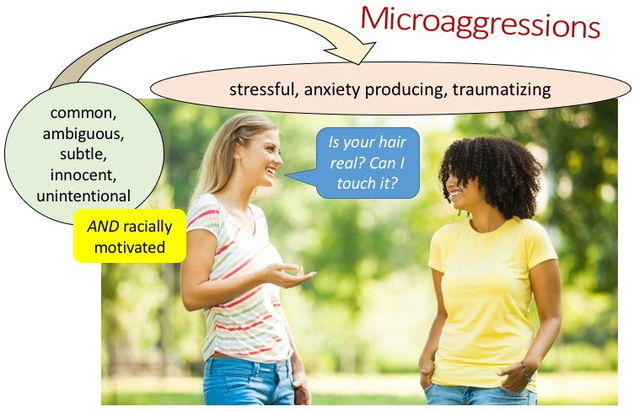Microaggression
Are Racial Microaggressions on College Campuses Harmful?
Critics describe complainers as part of a new "culture of victimhood.”
Posted November 12, 2017
Racial Microaggressions on Campuses
Racial microaggressions, a form of everyday racism, are commonplace on college campuses. Recent studies have shown that microaggressions are often present in the things people say and do, notwithstanding the intent behind them. Research over the past decade has connected experiencing microaggressions with symptoms of mental illness, including anxiety, depression, substance use disorders, and even suicidal ideation. It is thought that the unrelenting and unacknowledged experience of microaggressions leads to distress, frustration, and/or hopelessness—not unlike similar ongoing stressors, such as bullying or sexual harassment. One event may be easily managed, but as microaggressions accumulate, so does the stress.
Among all the major ethnic groups in the U.S., African Americans report the highest frequency of racial mistreatment, in the forms of both overt racism and microaggressions. This can be especially burdensome for black college students, who typically experience microaggressions on campus on a regular basis. In response, many campuses have implemented training and other interventions focused on reducing the commission of microaggressions.
Are Complainers Simply Neurotic?
Not everyone agrees that microaggressions are a problem, and in fact, some see the increased social dialogue surrounding the harms of microaggressions as a sign of a threatening shift in cultural values. Attempts to address the problem have been branded by some sociologists as the product of a new “culture of victimhood,” suggesting that victims of microaggressions are pathologically overly sensitive (Campbell & Manning, 2014, 2016). Indeed, Johnathan Haidt (2017), a business professor at NYU, referred to those complaining of microaggressions as “the most fragile and anxious students,” who are now being socially trained to “react with pain and anger to ever-smaller specks that they learn to see in each other’s eyes.” Psychologist Scott Lilienfeld (2017) has even questioned the connection between psychological harm and racial microaggressions, noting that the link may be better explained by the personality trait referred to as "neuroticism" or trait negative affectivity. People who are neurotic tend to be more anxious, overly sensitive, and are more likely to perceive and complain of victimization. He also notes that this trait is heritable, implying some genetic tendency for people of color to overreact to these experiences.

Given these assertions, it seems that a better understanding of the true relationship between microaggressions and neuroticism is critical, as it could have an impact on scientific and social movements to reduce microaggressions. This would also have important clinical implications for helping those claiming psychological harm from microaggressive experiences. If purported harms are completely caused by negative affectivity in people of color, then one may conclude that campuswide efforts to reduce microaggressions are unnecessary and may even be cultivating “atypical sensitivity” (Campbell & Manning, 2016). Scholars like Haidt and Lilienfeld have taken these ideas a step further and argued for a moratorium on microaggression training altogether (Haidt, 2017; Lilienfeld, 2017).
A Study of Microaggressions and Symptoms of Mental Disorders
We conducted a study to investigate these issues, building on another study we published recently where we examined the connection between microaggressions and racism. We had found that white college students who are more likely to commit microaggressions are also more likely to endorse symbolic, modern, and colorblind racist attitudes. Nearly all of the black participants in that study felt that being called “too sensitive” was a racist statement in context, and this sentiment on the part of white students was found to be associated with greater racism towards black people (Kanter et al., 2017).
For the current study, undergraduate students completed measures of anxiety, trauma, frequency of discrimination, trait negative affectivity (neuroticism), and ethnic identity. Unsurprisingly, black students reported experiencing significantly more racial microaggressions than white students. Black students also scored significantly higher than white students on trauma symptoms of discrimination and stress due to general ethnic discrimination.
How Are Negative Affectivity and Harms From Microaggressions Connected?
Negative affectivity was correlated to anxiety and trauma symptoms, which was to be expected since negative affectivity is correlated to most measures of psychopathology. So, it could be that people with greater trait negative affectivity are more likely to perceive discrimination, but it also could be that increased experiences of discrimination can result in more negative affectivity. This study cannot tease those possibilities apart.
However, when trait negative affectivity was controlled for, the frequency of experiencing microaggressions remained strongly correlated to anxiety, stress, and trauma symptoms in the black students. This demonstrated that microaggressions are linked to psychological harm, apart from any potential neuroticism on the part of the victim (Williams, Kanter, & Ching, 2018).
Further, black students scored significantly higher on trait positive affectivity, and they showed no differences in trait negative affectivity compared to white students. Although as noted, microaggressions were connected to symptoms of anxiety, overall black students were not significantly more anxious than white students. In other words, black students were not generally more angry or anxious, in contrast to Haidt’s conjecture. They were also no more neurotic, in contrast to Lilienfeld's assertions, and in fact had a significantly more positive disposition overall.
Higher ethnic identity—which is protective against the harms of racism—showed no connection to negative affectivity in black students. Interestingly enough, it was positively correlated to positive affectivity, as well as increased stress due to discrimination, and increased experiences of microaggressions. This may seem contradictory, but these results are consistent with previous studies that have shown that ethnic minority youth with a strong ethnic identity are both better adjusted and better able to perceive racism (Rivas-Drake, Hughes, & Way, 2009).
Are Microaggressions Harmful to White Students Too?
This particular study was focused on the experience of African American college students, since generally very few white students report experiences of racial discrimination. But research indicates that discrimination in any form is potentially harmful to the person on the receiving end, including discrimination due to race, gender, disability, religion, and sexual orientation. Likewise, it would seem that microaggressions would be harmful, whether or not the victims identify as people of color.
To that end, we reanalyzed the data to determine if racial microaggressions were harmful to white students in the same way they were for black students. Although white students reported far fewer microaggressions, we found the same relationships, with racial microaggressions being highly and significantly correlated to trauma symptoms, even after accounting for negative affectivity. In examining microaggressions subscales by race, for white students perceiving a lack of environmental representation or recognition was most traumatizing, whereas for black students it was not belonging (Williams, Kanter, & Debreaux, 2017).
Racial Differences in Experiences
There were large group differences in the amount of ethnic and racial discrimination reported by students, which was consistent with findings from other studies. Black students reported encountering approximately 70% more general ethnic discrimination and experiencing nearly twice as many racial microaggressions as white students. These wide differences in lived experiences of racism suggest that reactions to reports of racial maltreatment may be misunderstood by most white people, since they don't experience microaggressions very often. Microaggressions, which tend to be covert and subtle, may be more likely to escape the notice of those without such lived experiences and consequently be misinterpreted as oversensitivity on the part of the victim. This may explain why researchers such as Lilienfeld, Haidt, Campbell, and Manning, who are all white males, came to the wrong conclusions about the causes and impact of microaggressions. It's also worth noting that none of these scholars conduct much, if any, diversity research, and so their their ideas should be seen as opinions and not expert consensus.
Microaggression Education on Campuses
So, contrary to banning microaggression education, quite the opposite seems to be in order — more education is needed. Universities may be the ideal place to educate young people about the harms of microaggressions. Students who are prone to microaggress should learn that these behaviors are hurtful and are often a form of racism. Further, our results surrounding ethnic identity imply that black students will benefit by being able to put words to what is happening to them, as being able to identify and name racial microaggressions may make them better equipped to cope. Unfortunately, racial microaggressions are happening so frequently that most of the time they go unaddressed, and victims must often suppress their feelings and shrug them off.
In terms of clinical implications, when people report distress due to microaggressions, therapists should not immediately attribute this to personality factors. Rather, a careful, culturally informed assessment of racial stressors should be undertaken to understand the extent of the problem and to shape mental health care interventions. Microaggressions should not be dismissed as innocuous—rather they are harmful, and victims should be believed.
—by Monnica Williams, Ph.D., with Jennifer Purdon.
Read more at the Journal of Racial and Ethnic Health Disparities.
References
Campbell, B., & Manning, J. (2014). Microaggression and Moral Cultures. Comparative Sociology, 13(6), 692–726.
Campbell, B., & Manning, J. (2016). Campus Culture Wars and the Sociology of Morality. Comparative Sociology, 15, 147–178
Haidt, J. (2017). The Unwisest Idea on Campus: Commentary on Lilienfeld (2017). Perspectives on Psychological Science, 12(1), 176–177.
Kanter, J. W., Williams, M. T., Kuczynski, A. M., Manbeck, K. E., Debreaux, M., & Rosen, D. C. (in press). A Preliminary Report on the Relationship Between Microaggressions Against Black People and Racism Among White College Students. Race and Social Problems, 9(4), 291–299. doi: 10.1007/s12552-017-9214-0
Rivas-Drake, D., Hughes, D., & Way, N. (2009). A Preliminary Analysis of Associations Among Ethnic-Racial Socialization, Ethnic Discrimination, and Ethnic Identity Among Urban Sixth Graders. Journal of Research on Adolescence, 19(3), 558–584.
Williams, M. T. (2020). Microaggressions: Clarification, evidence, and impact. Perspectives on Psychological Science, 15(1), 3-26. doi: 10.1177/1745691619827499
Williams, M. T., Kanter, J. W., & Ching, T. H. W. (2018). Anxiety, stress, and trauma symptoms in African Americans: Negative affectivity does not explain the relationship between microaggressions and psychopathology. Journal of Racial and Ethnic Health Disparities, 5(5), 919–927. doi: 10.1007/s40615-017-0440-3
Williams, M. T., Kanter, J. W., & Debreaux, M. (2017, November). Psychometric Properties of the Anxiety Symptoms of Discrimination Scale in Black and White Students. Poster session at the 51st Annual Convention of the Association of Behavioral and Cognitive Therapies, San Diego, CA.




